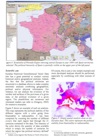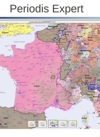And What Inbetween?
I - Why Do You Miss Some Key Moments in the History of Europe?
The Euratlas Periodis historical atlas does not aim to decree what are prominent moments in history. Nor does it narrate events like a historical novel or a match commentary. Euratlas Periodis does not show the causes of the events but only how things turned out.
1) A lot has happened in the intervals that doesn’t appear on the map.
A lot of changes are always and still happening everywhere in the world. Some changes are important, others are not. We are not in position to judge which is which; but we just describe the results each 100 years.
2) But the maps are of the years 1800-1900; why not 1804 or 1943?
Exactly, the Euratlas Periodis maps do show only the political situation of an area encompassing the main part of Europe, North Africa and the Middle East, at the very end of each century, from AD 1 to AD 2000.
3) Where is the map 1918-1939?
There is no Euratlas Periodis map for for either 1918 or 1939.
4) Don't you agree that maps of 1918 or 1921 would be useful?
There are persons who feel that maps for 1918 and 1921 would be good. There are other persons who are convinced that 1914 and 1920 or 1929 would be the right years. Actually, everyone, with some knowledge in digital cartography and geographical information systems (GIS) can purchase our Georeferenced Historical Vector Data 1900 and draw his own maps.
5) Your maps depict country borders at the beginning of each century. Do you have maps in the same scale and pattern dated 1850, 1914, 1918, 1937, for example?
No, but everyone, who has some knowledge in digital cartography and geographical information systems (GIS) can purchase our Georeferenced Historical Vector Data 1800, 1900 or 2000 and draw his own maps for the desired years.
6) Why don't you introduce a tighter rhythm in the last 200 years in order to show the Bourgeois Revolutions of 1848 and especially their consequences in the 20th Century. Or add 1850, 1920 (Interwar period after Versailles Treaty), 1942 (Nazi occupation), 1950 (Cold War until 1989)?
The notions of 'Bourgeois Revolution', 'Interwar period', 'Nazi occupation' or 'Cold War' are interpretations of history. We don't mean these interpretations are wrong, we only mean that the value of an interpretation lies in its consequences and we are precisely showing the consequences of each century, as far as they change borders. Moreover you will find a large part of the requested information in the World Historical Maps Hisatlas pages.
7) Why are you skipping from 1900 to 2000, missing so many important maps?
The notion of importance results of an interpretation of the past events. Actually, there is no objective criterion to define what was important in history from what was not. In some European countries, 1918 is a very important date, other countries give more importance to 1920 or 1926 for instance. Everyone considers the facts according to his own vision of the world.
8) Why haven't you chosen an interval of 20 years at least?
Mainly because sources and data are missing until the 15th or 16th century and it would have been inconsistent to draw the first 16 centuries at an interval of 100 years and the centuries close to our time at an interval of 20 years.
9) Don't you understand a lot of history is left out when one only sees the beginning of each century?
A lot of information may have been left out but the result of every time sequence is shown. Generally, a historian relies on the known sources and leaves out the many events which were never recorded. Actually, it's even worse because we don't know if the recorded events really happened or if the sources are narrating a kind of «official version» of what is supposed to have happened according to that time's political Weltanschauung.
10) Why map of borders after WW1 is missing?
As already mentioned, we have chosen a 100 years intervals because there is no objective criterion to define the relative importance of one specific year in the flow of history. Moreover, in the WW1 case for instance, you will notice that historians, depending on their national views, fix the year 1918 or 1920 or 1921, sometimes even 1923 as the real end of the war period.
12) Why is there a map for 1800 AD (not interesting) and not for 1812 and 1815, which were more significant historically?
There is no universal measurable criterion, relevant for all the centuries, that makes a year more 'significant' than another one. A measurable criterion could be, for instance, the number of deaths or the number of kilometers of boundaries that changed during a year, but, still, the relevancy is questionable.
13) Since 1812 is the climax and 1815 the fall of the Revolutionary-Napoleonic Wars, it's clear that these years are more important than the others. Why don't you show them?
The notions of climax and fall and the category 'Revolutionary-Napoleonic Wars' are historical interpretations and we want neither to confirm nor to invalidate these interpretations. We are not presenting the causes and reasons of the events, we simply try to describe the political situation of Europe at a fixed moment. It is the historians job to develop or invalidate theories, not ours. We do, however, pay attention to reported errors or omissions in the layout of the borders.
14) Since your maps are a simple summary of history, why don't present the common view of facts?
If you assume that all the historical events are fully known, at least by the scholars and specialists, then a simple summary of history is necessary to improve the culture of common people. However, if you consider that little is known without doubt in history, then maps trying to describe with accuracy a fixed point in time, could be useful to start an investigation. Moreover, such a presentation, clear and simple, can help everyone to discover what is known of our past.
About what is known or can be known in science, we would suggest the book
Invented Reality : How Do We Know What We Believe We Know? (Paul Watzlawick et al., 1984) in which the authors are suggesting that only measurable facts are likely to be true, 'true' in the common sense of the word.
: How Do We Know What We Believe We Know? (Paul Watzlawick et al., 1984) in which the authors are suggesting that only measurable facts are likely to be true, 'true' in the common sense of the word.
See also the article
From Historical Mapping To Historical Geographical
Information System

PDF format
or the presentation

PDF format
Periodical Historical Atlas of Europe
according to your needs